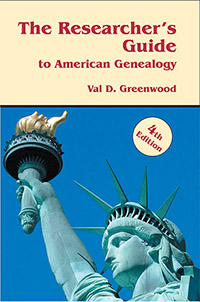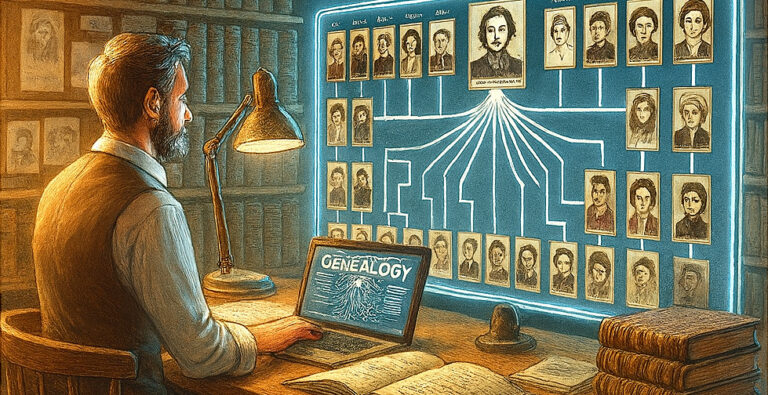
“Tree Talks” Speaks Highly of 4th Edition of The Researcher’s Guide to American Genealogy
The Central New York Genealogical Society has been publishing its journal, “Tree Talks,” for nearly sixty years. The June 2020 issue features a thoughtful review of the 4th edition of Val Greenwood’s Researcher’s Guide to American Genealogy. We are pleased to share with our readers below.
The Researcher’s Guide to American Genealogy by Val D. Greenwood, 4th edition.
Genealogical Publishing Co., 2017. Paperback, $49.95. 778 pgs. illus., index. ISBN 978-0-8063-2066-3.
Are you just becoming interested in your family history, this long, lovely, frustrating search for your ancestors’ and, thus, your own identity? Then this tome is for you, a guidebook to the many resources available to aid in your research and a textbook to teach you how to begin and then, how to proceed.
Or have you been researching your families for years, dutifully recording the who, what, where, and when of their lives? Filling out family charts, building the story of their lives from many sources? Then this book will serve as a guide to some resources you may have overlooked, to those that are now available online, or to other methods of discovering your ancestors.
Don’t be daunted by the number of pages. You probably won’t try to read it through, one chapter after another, although the writing is easy to follow and the author makes the topics quite interesting. However, using this book as a reference source—to dip into separate chapters that are relevant to your current research—is likely your best method.
The Preface is there to introduce you to the author, how and why he wrote this, and the changes he’s made in the editions; don’t skip over it because it will help you understand the author’s procedures. There are a few footnotes on each page; don’t skip over them because they have useful information that adds to the subject. And by organizing the book into two parts—“Background to Research” and “Records and Their Use”—you are able to organize your own thoughts and methods.
If you are familiar with a previous editions—the 3rd edition was published in 2000—you realize Greenwoods’ considerable effort in updating his work. In fact, two new chapters are included: Chapter 9, “Computer Technology and Family History,” 25 pages; and Chapter 10, “Family History on the Internet,” 36 pages. He emphasizes throughout the book that information about the Internet is likely out-of-date very quickly, so he includes many URLs to check for updates.
The illustrations and charts are extremely helpful. I think “newbies” to family history research will especially benefit from studying the federal census forms on pages 332 to 353, covering all the decennials from 1790 through 1890. Note that 1890 is included, more for reference to see what we will forever miss, as most of those census returns were destroyed in a fire in 1921. However if you are lucky enough to be researching in Westchester County (Eastchester) or Suffolk County (Brookhaven Township) in New York State, those fragments still exist. There’s a brief section on the 1940 census; he also mentions that the 1950 census is slated to be available in 2022. What is most helpful in Chapter 14, on census records, is the location of those returns online. Both Ancestry and FamilySearch have many of the census records, most especially the special censuses such as Manufacturing, Mortality, and Agriculture, and so does the National Archives. Then he covers “Using Census Records in Your Research” in Chapter 15.
Other illustrations show forms for everything from applying for naturalization records to copies of pension payment records. As you are researching your ancestor you may find you would like to see these original records. There are helpful guides and forms in several chapters that will guide your research.
On page 267 is an item of particular interest to me. It’s in Chapter 12 “Compiled Sources and Newspapers” in a list of genealogical and historical periodicals. Yes, Tree Talks is listed along with our address, in the three pages of periodicals!
One statement by Greenwood that I try to keep in mind, and to tell others who are also researching family history, is “… if you do thorough, quality research, much of what you do will involve records that are not available on the Internet.” That is why Tree Talks is publishing more and more information from county and town historians; they are not likely to be putting many of their holdings online. He also makes the point that it’s best to look at the original record, be it a census or a county’s vital records, just in case there’s more there than what the indexer or abstractor found. Of course, you may find some of those scanned and online, as well.
The author mentions other well-known genealogical guides by the “gurus” in various subjects. Those singular works are worth looking at for their in-depth treatment of a particular field. But for a comprehensive authority in the whole field of genealogical research, it’s hard to beat the 778 pages in this work for the valuable aid it gives to newcomers to this “hobby” and those who have been researching for years.
Joyce H. Cook, reviewer
Tree Talks, June 2020




